Identifying Six Clusters of Japanese Fathers
These days, the shape of Japanese families is becoming much more diverse. In this context, a father whose partner also works is an extremely attractive marketing target.
Thus we need to consider into what groups we can classify working fathers. To do so, let’s introduce profiles of the six clusters identified from a survey conducted by the Dentsu Papa Lab, which focuses its research on fathers in households with young children and in which both parents work.
Six Types of Fathers
The research involved conducting a cluster analysis of working fathers whose children are of junior high school age or younger (up to 15 years old). The survey asked about attitudes to childrearing, housework, careers and lifestyle values. Based on the subsequent analysis, fathers were classified into six clusters, the basic profiles and explanations of which follow.
1. All-round Fathers
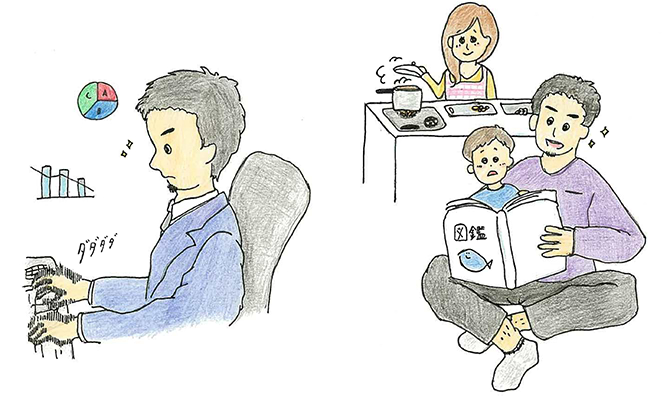
The All-round Fathers cluster centers on fathers 40?49 years of age with children attending elementary school. These fathers are enthusiastic about their work and have a strong ambitious drive. They are involved in daily housework and childrearing. They play a central role at home and in the workplace. They have a strong need for growth, and are motivated to advance in their careers and pursue self-development. Members of this cluster often use online shopping sites, tend to focus on the practicality and quality of products, and tend to carefully consider the merits of a product before purchase. Regarding future lifestyle, they indicate a desire to put their family first.
This cluster accounts for 15.6% of fathers surveyed.
2. Doubles-team Fathers
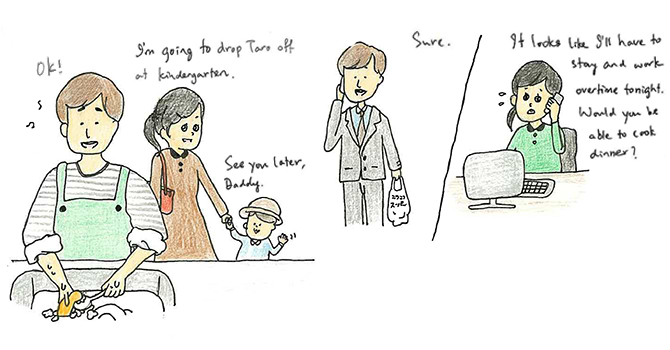
These fathers like to cook, and they take responsibility for meal preparation and washing up as part of the regular household routine. This cluster centers on fathers 30?39 years of age, who have preschool-aged children. They take the initiative to do general housework, such as cleaning and the laundry, and enjoy the time spent doing it. Similar to a doubles pair in badminton, this category of father tends to share responsibility for managing the household as a duo with his wife. Since they do housework daily, they are involved in choosing groceries, daily necessities and white goods. They are enthusiastic about improving their work-related skills and, in particular, have a strong desire to become self-employed or start their own business.
This cluster accounts for 19.0% of fathers surveyed.
3. Socialite Fathers
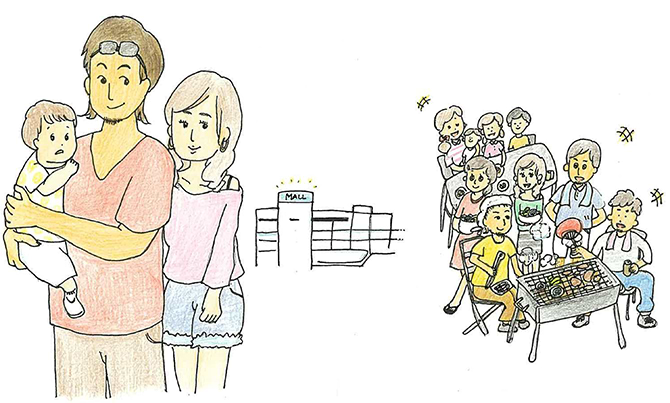
This cluster only accounts for a small percentage of the fathers in the target group studied. These fathers are mainly 30?49 years of age and enjoy being with people, valuing social relationships and community. Although they often invite the parents of their children’s classmates over for parties, their participation in housework, such as cooking, cleaning and doing the laundry, is relatively low. They are enthusiastic about education. With regard to actual purchasing behavior, they mainly buy non-essential items that they will use themselves, such as instant coffee and cigarettes.
This cluster accounts for 5.0% of fathers surveyed.
4. Self-promoting Fathers
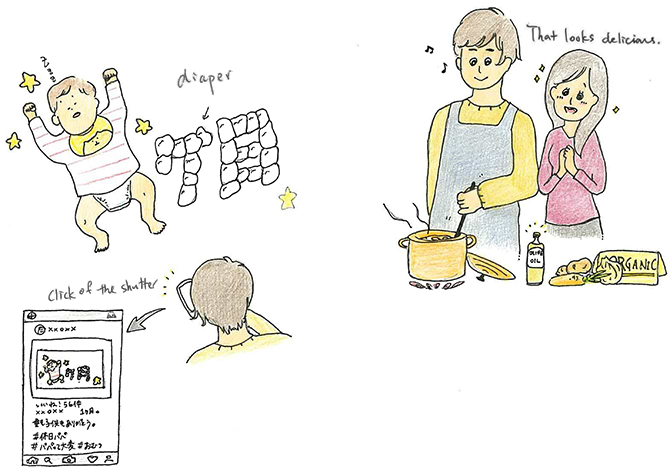
This cluster is centered on fathers 20?39 years of age. They exhibit a great need for approval, and their behavior is influenced by such criteria as how many “likes” they receive in a social media context. Members of this cluster are generally very involved in housework and childrearing. They see the time spent with their children as important, although part of their motivation may lie in the desire to post photographs of themselves on social media showing their childrearing activities. They want to teach their children proper discipline and manners, reflecting their desire to lead a lifestyle that places high focus on family relationships. They are also proactive in improving their job skills and developing their career.
This cluster accounts for 8.1% of fathers surveyed.
5. I’ve-done-my-bit Fathers
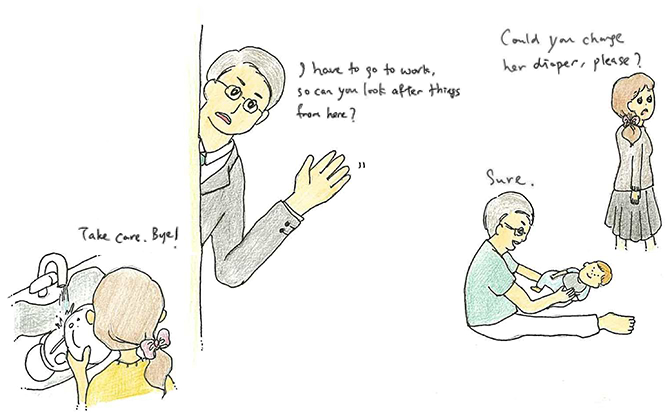
Although these fathers, conscious of their wives’ mood and wellbeing, often help with such chores as cleaning and putting out the garbage, they seldom participate in preparing meals. This cluster is centered on fathers 40?49 years of age, whose children are of elementary and junior high school age. Their stance on housework is to help out to the extent they perceive to be feasible and practical. Fundamentally, fathers in this cluster leave the running of the household to their wives. However, they have a strong interest in their children’s future and, while maintaining stability in their work situation, they seek to have a mentally and emotionally rich lifestyle.
This cluster accounts for 24.7% of fathers surveyed.
6. Lazybones Fathers

Among the six clusters identified, these fathers are the least involved in housework and childrearing. The group contains a slight bias toward fathers 50 years of age or older, and their children tend to be of elementary school age and older. Their involvement in housework and childrearing is low, and their attitude to career and work may be characterized as doing things in moderation. This is the largest cluster of fathers identified by the research.
This cluster accounts for 27.6% of fathers surveyed.
Socialite Fathers, All-round Fathers and Doubles-team Fathers Have the Highest Rates of Wives in Full-time Employment
Which of the six clusters of fathers have high rates of households in which both husband and wife work full-time?
Let’s take a look at the data on clusters that have particularly high rates of both husband and wife in full-time employment.*
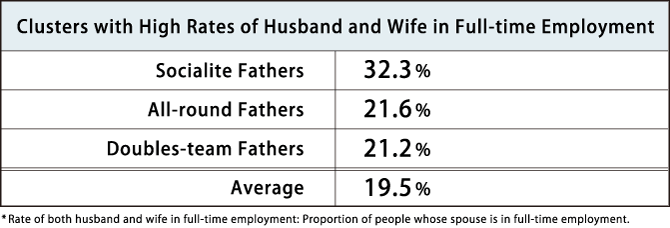
We can observe that the rate of both husband and wife in full-time employment is high for Socialite Fathers, All-round Fathers and Doubles-team Fathers (in descending order). In particular, the rate of involvement in housework and childrearing of All-round Fathers and Doubles-team Fathers reflects the characteristics of fathers in households where both partners work.
The graph below shows the correlation between income and involvement in housework and childrearing.
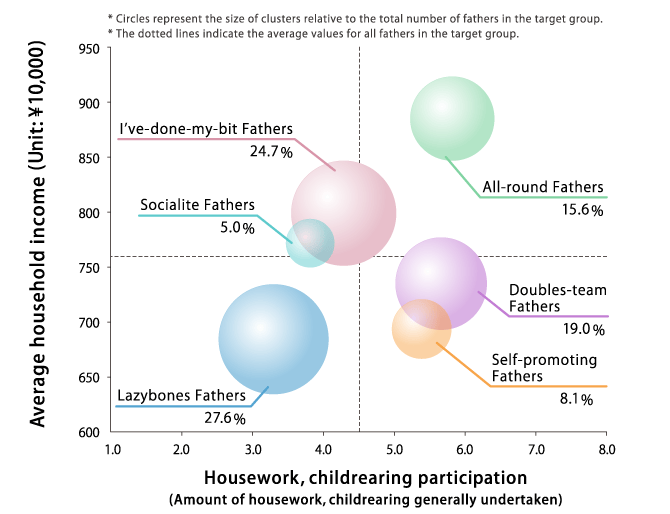
The cluster that stands out as a marketing target is All-round Fathers. Their incomes are high, as are their rates of participation in housework and childrearing. Next, are the Doubles-team Fathers, with moderately high incomes and high rates of participation in housework and childrearing. The cluster is very involved in running the household, is proactive when it comes to choosing groceries, daily necessities and white goods. The Dentsu Papa Lab plans to pay close attention to this cluster.
